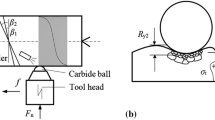Abstract
Due to the rapid development of the modern industry, people have higher and higher requirements on the rolling speed and quality of steel. The performance of conventional cast-iron roll cannot supply production demands because it contains higher chrome-nickel elements. The high-speed steel W6Mo5Cr4V2 with high service life, red hardness and wear resistance becomes a promising material of roll. However, the above characteristics bring great difficulties to roller repairing. Within this study, the high-speed steel W6Mo5Cr4V2 was processed with roll grinding at various grinding conditions (grain size, workpiece speed and depth of grinding) by using Taguchi design method, and the grinding process parameters are analysed and optimized according to the values of surface roughness and the depths of microhardness alterations. To obtain the optimized parameters, the values of surface roughness and microhardness alterations were analysed with grading methods of synthesizing multiple guidelines. Also, a confirmatory test was done to confirm the optimized parameters obtained from the above methods. The results of this work may provide the knowledge/database of the roll grinding process of high-speed steel W6Mo5Cr4V2 at given grinding parameters.







Similar content being viewed by others
References
Sagar SP, Murthy GVS, Das TK, Prakash A, Goel US, Venugopalan T (2013) Surface wave based ultrasonic technique for finding the optimal grinding condition of high-speed steel (HSS) work rolls. Steel Res Int 84(2):163–168. https://doi.org/10.1002/srin.201200133
Park JW, Lee HC, Lee S (1999) Composition, microstructure, hardness, and wear properties of high-speed steel rolls. Metall Mater Trans A Phys Metall Mater Sci 30(2):399–409. https://doi.org/10.1007/s11661-999-0329-9
Ghosh S, Paul S, Chattopadhyay AB (2009) Experimental investigations on grindability of bearing steel under high efficiency deep grinding (HEDG). Int J Abras Technol 2(2):154–172. https://doi.org/10.1504/ijat.2009.022585
Zhu CM, Gu P, Wu YY, Liu DH, Wang XK (2019) Surface roughness prediction model of SiCp/Al composite in grinding. Int J Mech Sci 155:98–109. https://doi.org/10.1016/j.ijmecsci.2019.02.025
Vendrame S, da Silva RB, Machado ÁR, Machado AR, Bianchi EC, Aguiar PR, Baptista FG, de Angelo Sanchez LE, Jackson MJ (2018) Surface integrity assessment of M3 HSS cutting taps after grinding at various machining conditions. Int J Adv Manuf Technol 98:617–627. https://doi.org/10.1007/s00170-018-2245-x
Kwak JS, Sim SB, Jeong YD (2006) An analysis of grinding power and surface roughness in external roll grinding of hardened SCM440 steel using the response surface method. Int J Mach Tools Manuf 46:304–312. https://doi.org/10.1016/j.ijmachtools.2005.05.019
Chatterjee S, Rudrapati R, Kumar Pal P, Nandi G (2018) Experiments, analysis and parametric optimization of cylindrical traverse cut grinding of aluminium bronze. Mater Today Proc 5:5272–5280. https://doi.org/10.1016/j.matpr.2017.12.110
Alajmi MS, Alfares FS, Alfares MS (2017) Selection of optimal conditions in the surface grinding process using the quantum based optimisation method. J Intell Manuf 30:1469–1481. https://doi.org/10.1007/s10845-017-1326-2
Tso PL, Lu CC (1999) Study on the grinding of P/M high-speed steel ASP60. Int J Mach Tools Manuf 39(4):627–638. https://doi.org/10.1016/S0890-6955(98)00049-2
Hood R, Aguirre FM, Gonzalez LS, Novovic D, Soo SL (2019) Evaluation of superabrasive grinding points for the machining of hardened steel. CIRP Ann Manuf Technol 68:329–332. https://doi.org/10.1016/j.cirp.2019.04.090
Yao C, Wang T, Xiao W, Huang X, Ren J (2014) Experimental study on grinding force and grinding temperature of Aermet 100 steel in surface grinding. J Mater Process Technol 214(11):2191–2199. https://doi.org/10.1016/j.jmatprotec.2014.04.013
Zhang H, Chen W, Fu X, Huang L (2012) Temperature Measurement and Burn Mechanism of Stainless Steel 1Cr11Ni2W2MoV in Grinding. Mater Sci Foru 723:433–438. https://doi.org/10.4028/www.scientific.net/MSF.723.433
Lan S, Jiao F (2019) Modeling of heat source in grinding zone and numerical simulation for grinding temperature field. Int J Adv Manuf Technol 103:3077–3086. https://doi.org/10.1007/s00170-019-03662-w
Bell A, Jin T, Stephenson DJ (2011) Burn threshold prediction for High Efficiency Deep Grinding. Int J Mach Tools Manuf 51(6):433–438. https://doi.org/10.1016/j.ijmachtools.2011.01.006
Chen ZZ, Xu JH, Ding WF Ma CY, Fu YC(2015) Grinding temperature during high-efficiency grinding Inconel 718 using porous CBN wheel with multilayer defined grain distribution. Int J Adv Manuf Technol 165–172. https://doi.org/10.1007/s00170-014-6403-5
He B, Wei C, Ding S, Shi Z (2019) A survey of methods for detecting metallic grinding burn. Measurement 134:426–439. https://doi.org/10.1016/j.measurement.2018.10.093
Aurich JC, Sudermann H, Bil H (2005) Characterisation of burr formation in grinding and prospects for modelling. CIRP Ann Manuf Technol 54:313–316. https://doi.org/10.1016/S0007-8506(07)60111-5
Kapur KC (1991) Quality Control Robust Design, and the Taguchi Method. J Qual Technol 23(2):173–173. https://doi.org/10.1080/00224065.1991.11979314
Ross PJ (1988) Taguchi Techniques for Quality Engineering, 2nd edn. McGraw-Hill, New York
Kwak JS, Kim IK (2006) Parameter optimization of surface grinding process based on Taguchi and response surface methods. Key Eng Mater 306-308:709–714. https://doi.org/10.4028/www.scientific.net/KEM.306-308.709
Zhang JZ, Chen JC, Kirby ED (2007) Surface roughness optimization in an end-milling operation using the Taguchi design method. J Mater Process Technol 184(1-3):233–239. https://doi.org/10.1016/j.jmatprotec.2006.11.029
Funding
This work was supported by Major Science and Technology Project in Guizhou Province (Grant No. Q.K.H.Z.D.Z.X.Z[2019]3016), Science and Technology Innovation Team Project in Guizhou Province (Grant No. Q.K.H.P.T.R.C[2020]5020), Preferred Project of Scientific and Technological Activities for Personnel Studying Abroad in Guizhou Province (Grant No. Q.R.X.M.Z.Z.H.T(2018)0001), Science and Technology Planning Project in Guizhou Province (Grant No. Q.K.H.P.T.R.C[2017]5788) and Training Plan for High-level Innovative Talent in Guizhou Province (Grant No. Q.K.H.P.T.R.C【2016】5659).
Author information
Authors and Affiliations
Corresponding author
Additional information
Publisher’s note
Springer Nature remains neutral with regard to jurisdictional claims in published maps and institutional affiliations.
Rights and permissions
About this article
Cite this article
Yuan, K., Wu, H., Yang, L. et al. Experiments, analysis and parametric optimization of roll grinding for high-speed steel W6Mo5Cr4V2. Int J Adv Manuf Technol 109, 1275–1284 (2020). https://doi.org/10.1007/s00170-020-05657-4
Received:
Accepted:
Published:
Issue Date:
DOI: https://doi.org/10.1007/s00170-020-05657-4




